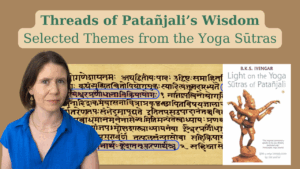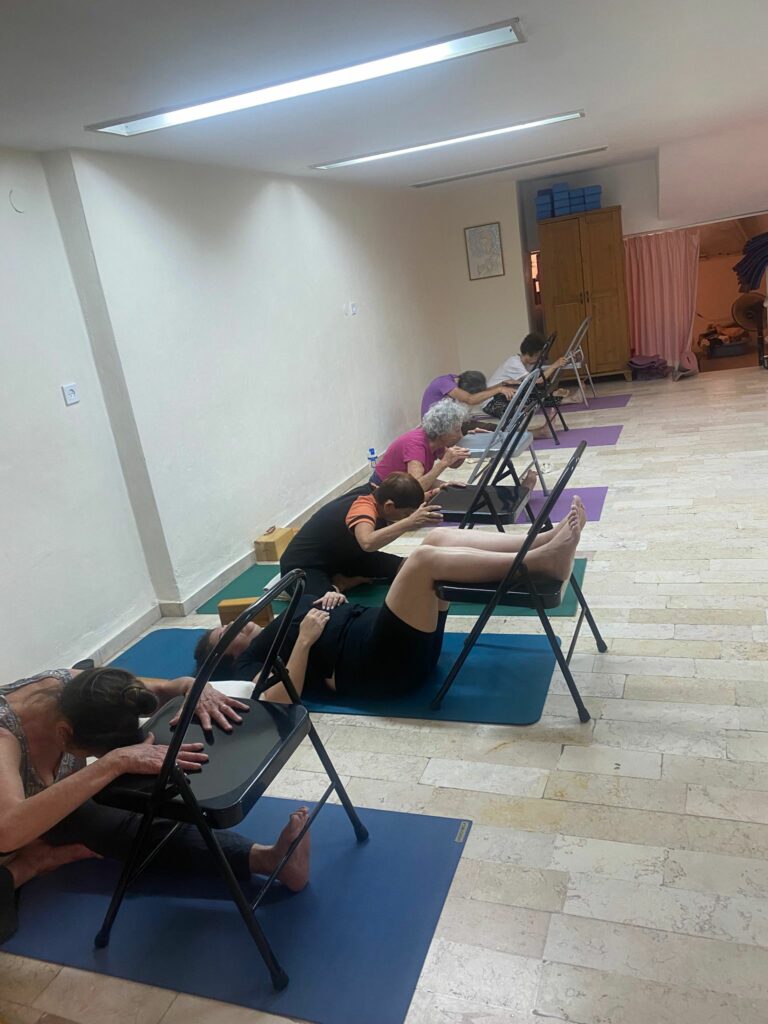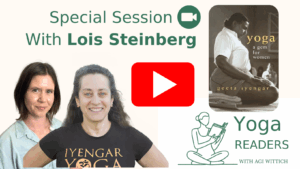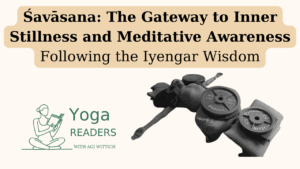
Threads of Patanjali’s Wisdom – Online Course
A course of selected themes from the Yoga Sutras with Dr. Agi Wittich The Yoga Sūtras of Patañjali are the philosophical heart of yoga.

As we journey through life, maintaining our physical and mental vitality becomes increasingly important. While the passage of time is inevitable, how we “age” is largely within our control. For many, the golden years are a time to embrace new hobbies, spend time with loved ones, and continue to live life to the fullest. However, age-related challenges such as reduced mobility, decreased strength, and a higher risk of falls can sometimes stand in the way.
This is where the ancient practice of yoga, particularly Iyengar Yoga, offers a powerful and accessible pathway to a more vibrant and independent older age. Far from being an exclusive practice for the young and flexible, Iyengar Yoga is uniquely suited to support the changing needs of the aging body, helping you move with grace, build resilience, and enhance your overall well-being.
The Transformative Benefits of Iyengar Yoga for Older Adults
Programs specifically tailored for older adults have consistently demonstrated that Iyengar Yoga provides significant, measurable benefits for healthy aging. Let’s explore some of these key areas, delving into the research that supports these claims:
1. Enhanced Mobility and Balance: Reducing the Risk of Falls
One of the most critical concerns for seniors is the risk of falls, which can lead to serious injuries and a loss of independence. Iyengar Yoga directly addresses this by improving key biomechanical factors and overall stability.
2. Building Strength and Preserving Bone Density
Aging often brings concerns about muscle weakness (sarcopenia) and bone density loss (osteoporosis). Iyengar Yoga offers a potent countermeasure through its emphasis on weight-bearing and controlled movements.
3. Holistic Mental and Emotional Well-being
The benefits of Iyengar Yoga extend far beyond the physical, profoundly impacting mental and emotional health.
The Iyengar Difference: Precision, Props, and Progress
What makes Iyengar Yoga uniquely powerful for aging bodies? It’s the inherent emphasis on precision, proper alignment, and the strategic use of props [Iyengar, B.K.S., Light on Yoga, 1966]. B.K.S. Iyengar himself stated, “Yoga teaches us to cure what need not be endured and endure what cannot be cured” [B.K.S. Iyengar, Interview, Yoga Rahasya, 2008], a philosophy particularly resonant for an aging population.
Precision and Alignment: Your Body’s Blueprint
Unlike some other yoga styles, Iyengar Yoga meticulously focuses on anatomical alignment in every pose [Iyengar, B.K.S., Light on Life, 2005, p. 29]. This precision ensures that each movement is executed safely and effectively, maximizing benefits while minimizing strain. For older adults, this means that by understanding how to align your body correctly, you avoid putting undue stress on joints or muscles that may be more vulnerable. Proper alignment ensures that the intended muscle groups are engaged and the full therapeutic potential of each pose is realized. As B.K.S. Iyengar noted, “Equi-distribution of energy and equi-flow of intelligence within the frame of body and the banks of the body in each asana is alignment for me.” [B.K.S. Iyengar, Yoga Wisdom & Practice, 2009, p. 32]. This meticulous attention to evenness and balance is particularly protective for aging bodies. He also emphasized that in a correct asana, “When an asana is done correctly, the body movements are smooth, and there is lightness in the body and freedom in the mind. When an asana is felt as being heavy, it is wrong.” [B.K.S. Iyengar, Light on Life, 2005, p. 32].
The Power of Props: Accessibility and Support
Blocks, straps, blankets, chairs, and wall ropes are not just accessories in Iyengar Yoga; they are integral tools that make the practice accessible to everyone, regardless of age, flexibility, or physical condition [Iyengar, Geeta S., Yoga: A Gem for Women, 1990, pp. 13-14, 96]. For aging bodies, props:
Controlled Loading: A Therapeutic Approach
While general yoga practice is known to improve balance and strength, Iyengar’s unique and precise application of props enables a controlled and progressive “loading” of joints and muscles [Iyengar, B.K.S., Interview, Yoga Rahasya, 2008]. This is a game-changer for older adults.
Iyengar Yoga and “Successful Aging”
The comprehensive improvements observed across physical (mobility, strength, balance, bone density, arthritis relief), mental (well-being, mood, stress reduction), and overall quality of life measures, as highlighted in research, align directly with the concept of “successful aging” [Gerontology Quarterly, 2022]. This holistic framework encompasses not just the absence of disease, but also the maintenance of physical, mental, and social well-being throughout later life.
This indicates that Iyengar Yoga is not merely a physical exercise for seniors; it functions as a comprehensive lifestyle intervention that promotes holistic well-being. It simultaneously addresses multiple age-related challenges, fostering resilience and vitality. Its inherent adaptability ensures that the practice remains accessible and beneficial across a wide spectrum of physical abilities in older populations, supporting continued vitality and independence. It’s about empowering you to continue living a full, active, and joyful life, no matter your age.
For further exploration of reclaiming agency through choice in practice (key for growing older with grace and empowerment), see Empowerment Through Choice: Understanding Autonomy in Trauma‑Sensitive Iyengar Yoga
Old Age from an Iyengar Yoga Perspective
Iyengar Yoga views old age not as a period of inevitable decline but as a unique and valuable stage of life, offering profound opportunities for continued growth, self-discovery, and spiritual evolution. Both B.K.S. Iyengar and Geeta S. Iyengar have extensively written and taught on this subject, emphasizing adaptation, acceptance, and the deepening of practice.
Geeta S. Iyengar highlights that “Yoga is a gift for old age.” She asserts that “One who takes to Yoga when old gains not only health and happiness but also freshness of mind, since Yoga gives one a bright outlook on life and one can look forward to a happier future rather than looking back into the past which has already entered into darkness.” She further states that “The loneliness and the nervousness which create sadness and sorrow are destroyed by Yoga as a new life begins. Hence it is never too late to begin. Yoga if started in old age is a rebirth which teaches one to face death happily, peacefully, and courageously. Hence nobody is exempted from doing Yoga practice and there are no excuses for not doing Yoga. How useful Yoga is can only be understood by practising it.” [Geeta S. Iyengar, Yoga: A Gem for Women, 1990, p. 56]. She reinforces this by quoting the Hathayoga Pradīpikā: “The young, the aged, the diseased, and the weak – all may take to the practice of Yoga and derive its benefits without hindrance.” [Geeta S. Iyengar, Yoga: A Gem for Women, 1990, p. 50].
B.K.S. Iyengar, reflecting on his own aging process, echoed these sentiments. He acknowledged, “Aging is a natural phenomenon. It is growth from childhood to adolescence, to middle age, and to old age… The fragrance of life in each of us begins to dry out as we age.” However, he quickly countered this with the transformative power of consistent practice: “I am also aging but my yogic practice, for hours together, is very regular like the rising and the setting of the sun. I have gained sixty years of bonus life because of my regular practice, therefore I am not afraid of death. I am ready to embrace death with ease because through yoga I made life worthy for myself and for others.” He viewed old age as a period for reflection and continued contribution: “At this age, one should reflect on one’s thoughts and one’s actions. One should guide one’s family and friends so that they do not commit the same mistakes as oneself…” [B.K.S. Iyengar, Yoga Wisdom & Practice, 2009, p. 54]. He also famously stated, “Death and dying are two different things. Death is full stop to the present life, but dying is a process… I am neither concerned about death nor dying… So, I do not waste my time on thinking of death but do yoga to live holistically every moment. Face the fear of dying courageously then death becomes glorious and majestic.” [B.K.S. Iyengar, Yoga Wisdom & Practice, 2009, p. 60].
A core principle for seniors in Iyengar Yoga is adaptability. B.K.S. Iyengar himself, even at 90, stated, “Even though age is telling upon me, I am still experiencing new feelings in daily practice.” He advocated for using props to sustain practice: “I happily use the props to retain and sustain my practices rather than escaping them on the pretext of my age.” He emphasized that consistency, not intensity (as understood by younger practitioners), is key: “Even at this age, my body is strong, my mind is agile, and my intelligence is steady and clear.” [B.K.S. Iyengar, Yoga Wisdom & Practice, 2009, pp. 55, 44]. He further expressed his dedication to lifelong practice, saying, “If one wants a good garden, he needs to tend [to] it each day. The moment he stops taking care of it, it dries up. If one does not use a blade, it rusts… It is the same with the body, breath, and mind. They need to be tuned each day. Otherwise they become insensitive.” [B.K.S. Iyengar, Yoga Wisdom & Practice, 2009, p. 58]. He also emphasized the ongoing transformation: “I won’t say changing no. My practice is not changing. It is transforming. It is becoming subtler and finer. The change is impermanent… In me, only progressive transformation is taking place.” [B.K.S. Iyengar, Yoga Wisdom & Practice, 2009, p. 48].
The philosophical foundation for this enduring practice in old age comes from the concepts of mobility in stability and listening to the body. Geeta S. Iyengar clarified that “The origin of stability is in mobility. Nobody can reach stability straight away unless one deals with mobility.” This means continuous, adaptive effort is essential, especially as physical abilities change with age. “Mobility is the inspiring stimulus to proceed whereas stability is the static energy to maintain self-balance or a self-force to have firmness.” [Geeta S. Iyengar, Mobility in Stability, 2007, p. 7]. B.K.S. Iyengar advised, “Your brain may say, ‘We can do it.’ But the knee may say, ‘Who are you to dictate to me? It is for me to say whether I can do it or not.’ So you have to listen to what the body says.” [B.K.S. Iyengar, Light on Life, 2005, p. 49]. This patient, intelligent listening allows practitioners to modify poses and avoid injury, ensuring a lifelong practice.
The ultimate aim is not just physical well-being, but mental and spiritual clarity in later years. B.K.S. Iyengar believed that “The body ages but the soul does not. When one is aged, the mind fuels a negative attitude toward life. By the power of will over mind, old age can be lived benevolently through yogic practices.” [B.K.S. Iyengar, Yoga Wisdom & Practice, 2009, p. 54]. He also famously stated, “Why worry about it? Death is certain. Let it come when it comes. Just keep working. The Soul has no age. It doesn’t die. Only the body decays. And yet, we must never forget the body, since it is the garden we must cherish and cultivate.” [B.K.S. Iyengar, Light on Life, 2005, p. 98].
In essence, Iyengar Yoga encourages older adults to embrace their age with grace, continuing their yogic journey not despite, but because of, the wisdom and subtleties that come with life experience. It’s a path that offers rejuvenation, resilience, and a profound sense of peace as one approaches the later stages of life.
☕ Appreciate the content? Buy me a chai and support my work sharing yoga wisdom with diverse communities.
💬 Want to talk yoga? Visit Talk Yoga to Agi to book a free conversation about your practice or needs.
Reflective Questions for Your Yoga Journey
Engaging in any practice with intention deepens its impact. Here are some reflective questions for both students and teachers of Iyengar Yoga, designed to foster growth and understanding.
For Students: Cultivating Your Practice
For Teachers: Guiding with Wisdom and Compassion
Embrace the Journey
Iyengar Yoga offers a profound opportunity to “age with grace,” fostering not just physical strength and flexibility, but also mental clarity, emotional balance, and a renewed sense of purpose. It’s a testament to the fact that well-being is a lifelong pursuit, and with the right tools and guidance, every stage of life can be lived to its fullest potential. Embrace the journey, and discover the transformative power of Iyengar Yoga for a healthy, vibrant future.
References

A course of selected themes from the Yoga Sutras with Dr. Agi Wittich The Yoga Sūtras of Patañjali are the philosophical heart of yoga.

In a recent Yoga Readers session, Dr. Lois Steinberg opened her teaching archives and personal memories, sharing stories that span four decades of study

In the vast and intricate repertoire of yoga āsanas (postures), Śavāsana (Corpse Pose) holds a unique and profoundly significant position. Often superficially perceived as
Agi Wittich is a yoga practitioner since two decades, and is a certified Iyengar Yoga teacher. Wittich studied Sanskrit and Tamil at the Hebrew University of Jerusalem, Israel, completing a PhD with a focus on Hinduism, Yoga, and Gender. She has published academic papers exploring topics such as Iyengar yoga and women, the effects of Western media on the image of yoga, and an analysis of the Thirumanthiram yoga text.